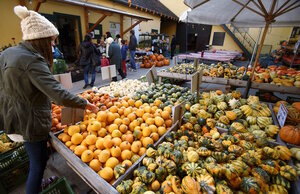Food industry is caving to consumer demands for natural ingredients
It can be hard to avoid all artificial ingredients, but the food industry is slowly starting to respond to consumers' demands. Natural ingredients are increasing in availability.

Various kinds of pumpkins, out of some 400 on display grown this season, are seen on sale at Franzlbauer farm in Hintersdorf, Austria, October 27, 2015. Consumers are demanding natural ingredients in food.
Heinz-Peter Bader/Reuters/File
In his Six Rules for Eating Wisely, author Michael Pollan cautions against consuming foods that our great-great-great grandmothers wouldn’t recognize. However, that’s often easier said than done.
While a 2015 Nielsen survey indicates that an increasing number of Americans want fresh, natural, and minimally processed foods, Azodicarbonamide, also known as the yoga mat chemical, has been identified in almost 500 food products. Still, the tides are turning as fast casual restaurants, fast food chains, and even multinationals are responding to pressure, especially from Millennials, for food made without artificial ingredients.
In 2013, industry leader Chipotle became the first restaurant chain to indicate which items on their menu contained genetically modified (GM) ingredients. Today, the company is currently working on improving their tortilla to remove propionic and benzoic acid, two preservatives used to inhibit the growth of mold and bacteria. Similarly, by the end of 2016, bakery chain Panera Bread will eliminate all artificial preservatives, sweeteners, colors, and flavors identified on their No No List. Some examples include nitrates and nitrites, titanium dioxide (used to add brightness to cheese), and aluminum potassium sulfate.
Faced with lagging sales, fast food chains are making changes to prevent falling further behind. Taco Bell will remove artificial preservatives and additives “where possible” by the end of 2017 while McDonald’s has reduced the number of ingredients in its grilled chicken breast from 18 to 12. Multinationals such as General Mills and Kraft are also following suit, with the cereal brand planning to use fruit and vegetable juices instead of green and blue dyes in Trix. Starting in 2016, Kraft macaroni and cheese eaters will seeannatto seed and paprika extract replace Yellow No. 5 and 6.
As industry standards for transparency in the supply chain continue to evolve, consumers can consult the Environmental Working Group’s Food Scores database for information on nutrition, ingredient, and processing concerns in more than 80,000 foods.
This article first appeared at Food Tank.

